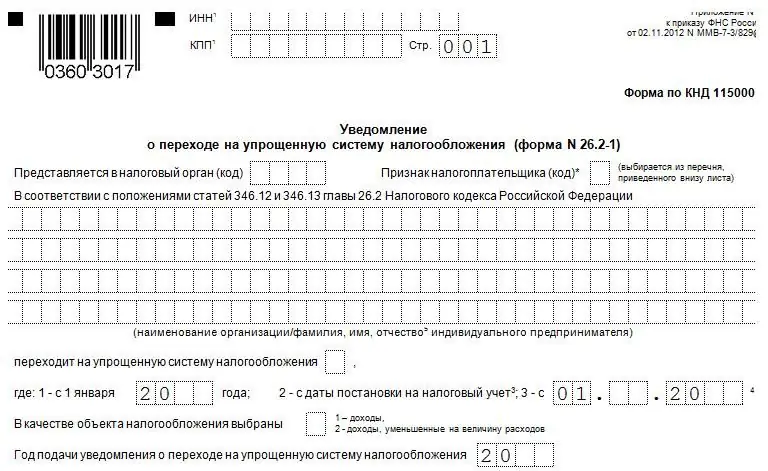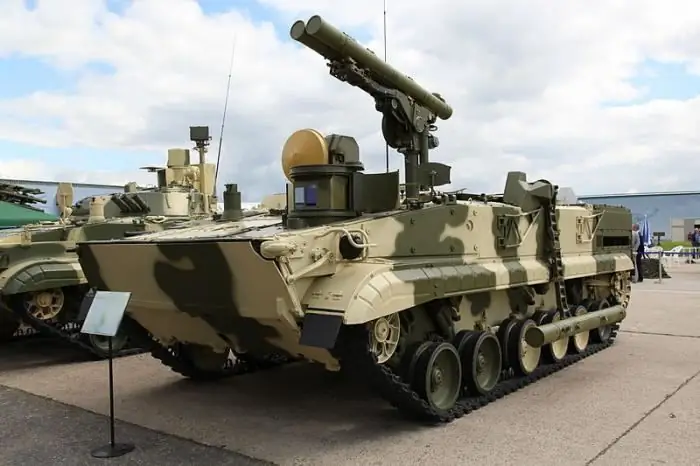2025 Author: Howard Calhoun | [email protected]. Last modified: 2025-01-24 13:10:47
Since the First World War, tanks have quickly become a real headache for the infantry. Initially, even when equipped with primitive armor, they did not leave a chance for the fighters. But even during the Second World War, when regimental artillery and anti-tank rifles (anti-tank rifles) appeared, tanks still dictated their own rules of engagement.

But then the year 1943 came, marked by one of those few cases when the engineers of Nazi Germany were able to create not only effective, but also the most effective weapon, the Faust cartridge. It was on its basis that the famous RPG-2 was created after the war, which, in turn, became the ancestor of the legendary RPG-7.
But the constant "battle of armor and projectile" and did not think to stop. Composite armor appeared, which was not so easy to penetrate with a conventional grenade launcher. In addition, experiments were already in full swing to create a dynamic and active systemprotection that all normal MBTs of the world are equipped with today. A new countermeasure was needed.
Portable infantry anti-tank systems became such. In their appearance, their working part strongly resembles the same grenade launcher, only the “pipe” is attached to a special support, on which numerous guidance and control tools are mounted. The projectile is not a rocket-propelled grenade, but a full-fledged anti-tank missile, even a small one.
Today we want to tell you about Cornet. The anti-tank missile system of this model has long been in service with our army and theoretically allows you to effectively counter all modern MBTs of a potential enemy.
Begin development
No matter how difficult the situation was in the 90s, but, to the credit of domestic gunsmiths (Tula Design Bureau), work began on a completely new model of weapons. Already in 1994, the first complexes began to enter service with our army. In fairness, it is worth noting that the work did not start from scratch: the Reflex anti-tank complex was used as the basis, which at that time could be installed on all domestic tanks, as well as Sprut-S and Sprut-SD self-propelled guns "".
But all the domestic anti-tank systems that existed at that time had one, but a very significant drawback. We are talking about a control method: either wired, when the military had to rush around with coils, or through radio commands, which could well be suppressed by enemymeans for setting active jamming.
"Management features" of the new ATGM
What was the difference between "Cornet"? The anti-tank missile system of this type was equipped with control systems similar to those used in the aviation industry. Firstly, a fairly powerful laser emitter is mounted on the installation itself, which effectively illuminates the target. The design of the latter has a photodetector that catches the reflected beam. The missile's homing system interprets the received data and is able to fine-tune the flight course.

Note that the ATGMs of the previous generation had one more problem: the accuracy of hitting almost 90% depended on the professionalism of the operator and his firm hand. The soldier had to literally manually adjust the missile's flight, constantly aiming it at the target. For this, a joystick was used. Imagine a situation when an enemy vehicle at this time does not stand still, but actively maneuvers, trying to cover the operator with all available types of weapons: as soon as he pulls his finger a little harder, that's it, the missile misses the target.
The wires were often torn, being torn by fragments or bullets, and it was impossible to insure against their banal grinding. Radio control often jammed.
Cornet was completely deprived of such shortcomings. The anti-tank missile system is completely autonomous, equipped with “smart” missiles that do not need to be fired manually. Of course, theoretically, a laser beam can be reflected anddissipate using a smoke screen. But, as practice shows, this takes a relatively long time. The speed of the rocket is such that even if its exact coordinates are lost 100-300 meters from the target, the ammunition will cover this distance in such a short period of time that the enemy tank will still not go anywhere.
Thus, the Kornet complex is a highly reliable weapon that allows you to confidently hit enemy armored vehicles in various conditions.
What tasks were set for the designers?

Starting from the mid-80s, almost all tanks of the Western powers were equipped with dynamic protection systems, and therefore the Tula people faced a “simple” task: to ensure reliable destruction of equipment protected by this method. Not surprisingly, the Kornet 9M133 missile under development was immediately equipped with a tandem warhead. Its first element disabled the remote sensing, provoking its operation, and the second part hit the tank armor directly.
By the way, because of this, the design of the rocket was quite remarkable. So, the shaped charge is in the tail, the engine is in the middle, and the primary charge is in the bow. Control systems are aft.
Unconventional uses
However, not only tanks can destroy "Cornet". The anti-tank missile system may well be used in a somewhat unconventional way.
The fact is that various anti-tank systems of various configurations have beenweapons were often used by soldiers as an effective means by which the enemy could be quickly smoked out of a fortified bunker. So, during the battle for the Falklands in 1982, British paratroopers very often took fortified areas, suppressing their resistance precisely with the help of their anti-tank systems.
Our special forces, using "Bassoons", knocked out spooks from their caves, and the Russian Armed Forces used these weapons during the second Chechen campaign. It turned out that "Bassoons" are extremely effective in clearing buildings. In a word, in recent years there have been a lot of such examples.
It is only important to take into account that ATGM missiles are not thermobaric munitions, and therefore their use against enemy manpower does not always lead to the desired results. The Tulyaks, having appreciated the combat experience of the Soviet and Russian troops, created missiles specially for the Kornet, equipped with just the same thermobaric warhead. Such a projectile, hitting the closed space of a fortified bunker, literally tears apart all life inside due to a sharp pressure drop that occurs during the explosion.
In a word, the Kornet missile is a truly multi-purpose weapon that can be extremely widely used in all branches of the military.
Western versions
Across the world, there is an active trend towards the complete abandonment of anti-tank systems, which require a qualified operator to operate. Western ATGMs include American Javelins and Israeli Spikes. Their operator is guided by the principle of "fire and forget". It's believed thatsuch complexes belong to the third generation. Our Kornet complex, by the way, belongs to the second one.
A missile fired from such systems is guided not only by the laser beam and engine heat emanating from the target, but also by the reference image of enemy equipment, which is embedded in its memory.

The main problem of the same "Javelin" is the extremely high cost of ammunition. One missile may well cost 120-130 thousand dollars. And that's for one piece! Far from all countries of the world can afford to equip their armies with such anti-tank systems, despite all their undoubted merits. So, in India, not so long ago, work was announced on a self-propelled anti-tank complex (based on infantry fighting vehicles), which is armed with Javelins alone. So, the cost of the chassis and the combat complex itself are equal. However, the ATGM costs even a little more.
On the contrary, in the same Syria, crafts based on the Kornet-E ATGM mounted on the ubiquitous BMP-1/2 were repeatedly noticed. Taking into account the fact that the complex itself and the rocket cost about 30 thousand dollars, their price is much lower than the cost of the chassis, which makes the production of such complexes economically feasible.
Besides, the western complexes of the third generation have another problem. It is expressed in a smaller effective range. So, the Javelina missile can theoretically fly away to 4,700 meters at once, but its homing part is effective only at a distance of up to 2,5 thousand meters. Installing such complexes on a large BMP chassis is simply pointless: while the cargets close to the tank, he will have time to hit her several times (including his own missiles).
There are serious problems in urban combat. So, in 2003, the Americans knocked out all Iraqi tanks and infantry fighting vehicles without any problems. But that was only in the open. There were no cases of using Javelins in armored vehicles in cities. That is why the Americans (and then the Israelis) equipped their third-generation complexes with manual control.
Russian solution
Soon, the Tula people significantly upgraded the Kornet: the ATGM received an “intelligent” target tracking system. Its use looks like this: the operator first visually detects the target, directs the ATGM in its direction, and then puts a mark. After the rocket is launched, it orients itself in space, without requiring any human participation in this process. Due to this, the Kornet is an ATGM that can even be used for guaranteed destruction of enemy helicopters.
If you think that the Javelin, with its 4,5 thousand meters, looks good, then the domestic development is generally unique in this regard. So, provided that it is equipped with new missiles with the help of the Kornet, it is possible to knock out a tank at a distance of eight to ten thousand meters. Moreover, the probability of hitting a target is consistently high over the entire possible range of application.
Some modifications
At present, our troops are receiving a fully modernized version of the complex under the index "D", while Kornet-EM is being exported. In general, there is no particular difference between them. Shouldnote that literally over the past couple of years, the Tiger car has become the main chassis for this complex. In addition, the Airborne Forces are now receiving a special Kornet anti-tank missile system, which is mounted on the BTR-D chassis. What other modifications are available?
What does index "E" mean?

The first ATGM was presented to the public in 1994, and the name "Kornet-E" was used. What it is? The index in this case denotes the export version. Its differences from the version that is in service with the domestic Armed Forces are minimal, coming down to instructions and signatures on control units made in English (or any other, depending on the wishes of the customer).
In general, it is the Kornet-E anti-tank missile system that is most often found in various "hot spots" around the world. The reasons are simple: it is cheap, as easy to learn as possible and is able to reliably hit almost all existing types of armored vehicles.”
Armored version
Oddly enough, but this complex is now considered as a very promising "additive" to the "Pantsir" system. We have already talked about the reasons: with new missiles, it will easily shoot down not only enemy UAVs, but even a combat helicopter. In this case, a kind of “symbiosis” of technology is used: the powerful detection system of the “Shell” detects the target, and only then the anti-tank missile system “Kornet” destroys it. Oddly enough, but for one launch of an ATGM missile, one UAV is shot down, while to destroy it from automaticguns "Pantsir" requires at least a hundred shells.
Of course, such targets can be destroyed with 100% probability by anti-aircraft missiles, only their cost is such that such shooting will be too costly. In addition, current drones can easily deceive the Pantsir's laser guidance system, while a simple ATGM missile is guided solely by the visual tracking of the target, without the need for laser illumination.
The Kornet-D anti-tank missile system was created specifically for the destruction of air targets, but other ATGMs of this family can also be used for this purpose.
At present, the idea of installing the complex on patrol ships and boats of the Russian Navy also looks very promising (this is no longer an idea, such modernization is underway). So in just 20 years, this development of Tula craftsmen has gone from an "advanced" means of destroying armored vehicles to a multifunctional weapon system that can destroy targets on land, in the air and at sea.
Emka
But the most promising for the "mass consumer" still looks exactly "Kornet-EM", mounted on the chassis of the "Tiger". For the first time, the development was demonstrated during the MAKS-2011. This system has no analogues in the world.
In this case, the complex is equipped with 16 missiles at once, half of which are in protective containers and are completely ready for combat use. Salvo firing at a target is possible when two missiles “work” at the same time on a tank. It is possible to fire all types of ammunition thathave ever been developed for this weapon. The huge advantage that the Kornet-EM anti-tank missile system has is the widespread use of affordable chassis and materials in the production, which dramatically reduces its cost compared to Western models.
Main Specifications

Minimum firing range - 150 meters. The maximum is 10 kilometers. The control of the installation is fully automated, the electronic "stuffing" is reliably protected from possible active interference from the enemy. It can simultaneously lead and fire at two targets at once. The cumulative part can penetrate up to 1300 mm of homogeneous steel armor. The high-explosive version of the rocket carries an explosive charge equivalent to 7 kilograms of TNT. The transition of the complex from traveling to combat takes only seven seconds.
For the first time in the history of the domestic arms business, the “fire and forget” scheme was implemented. Due to the almost complete elimination of a person from the missile control process, it was possible to almost 100% increase the probability of hitting a target on the first try. It should be noted that the old Kornet-E complex has almost two times worse characteristics. The ability to automatically assign and track a target has a positive effect on the psycho-emotional state of the personnel, who can focus on driving the vehicle and laying retreat routes.
In principle, this complex can be mounted on more than one "Tiger". So, uses an anti-tank missilecomplex cornet chassis BMP-3, and in this version (due to better booking) the installation is recommended for use in intense urban battles. How heavy is the load on the carrier vehicle's chassis?
Depending on the number of launchers, the mass of the Kornet-EM ATGM can vary from 0.8 to 1.2 tons, which is practically irrelevant for the chassis of the same Tiger (which is borrowed from an armored personnel carrier). The containers themselves are made of high-strength plastic. The guaranteed storage period for missiles without routine checks is at least ten years.
Composition of the complex
Firstly, the complex includes the chassis itself, equipped with an operator's cabin with a sight and other devices. As we have already said, our military-industrial complex most often puts forward the Tiger car for this role. The peculiarity of the complex in this case is also that it looks far from being an accurate ATGM, but like an ordinary jeep, since the missiles are hidden in its body. In the event of a real threat, the container takes its position on the chassis in just seven seconds.
The missiles themselves, and their nomenclature can be different - from direct anti-tank weapons to high-explosive fragmentation varieties, can be used against enemy manpower in urban combat. They have an effective range of up to ten kilometers. It is reported that the tandem part of the missile can hit infantry hiding behind concrete walls, the total thickness of which reaches about three meters.
Anti-tank missiles. It is reported that it is most reasonable to use them onranges up to eight kilometers. The armor penetration of their cumulative part is about 1100-1300 mm of homogeneous armor. In principle, such characteristics make it possible to effectively use the Kornet to combat all types of NATO MBTs, even taking into account the fact that there is a tendency to increase the thickness of the frontal armor. Finally, the ammunition can include thermobric shells, which are designed specifically to destroy enemy manpower, which is protected by the walls of the bunker.
Launcher with four protected launch containers. Equipped with telethermovision sighting device. A third generation thermal imager is used. For the convenience of the calculation, high-resolution television cameras are used, which greatly facilitate the identification of enemy equipment and protective structures. There is also a built-in laser rangefinder, which allows you to determine the distance to the target with high accuracy.
Flaws
Does the domestic "Cornet" have any negative features? The anti-tank missile system (photo is in the article) differs from its foreign competitors by excessively large weight (about 50 kilograms). In addition, a number of modifications still use laser beam guidance, which greatly unmasks the position taken by the fighters. However, it is precisely because of the latter circumstance that the Kornet-EM complex is mounted on the chassis of a relatively fast Tiger, which allows you to quickly change the location of the firing point.
In addition, some experts testify that only 47% of hits result in armor penetration. Such data, in particular, were obtained during the war between Lebanon and Israel in 2006.

But there are other data. Thus, the US military department, reluctantly, was forced to admit the presence of lost Abrams MBTs in Iraq (as of 2012). British journalists cite as an example an episode when, on a narrow street, the Abrams was literally stuffed with RPG-7 shells that did not harm him. But only one volley from the "Cornet" completely disabled the tank, destroying the crew. The car, according to eyewitnesses, immediately caught fire.
Recommended:
Using the simplified tax system: system features, application procedure

This article explores the characteristics of the most popular taxation system - simplified. The advantages and disadvantages of the system, conditions of application, transition and cancellation are presented. Different rates are considered for different objects of taxation
Staffing of the personnel management system. Information, technical and legal support of the personnel management system

Since each company determines the number of employees independently, deciding what requirements for personnel it needs and what qualifications it should have, there is no exact and clear calculation
Centralized management: system, structure and functions. Principles of the management model, pros and cons of the system

Which management model is better - centralized or decentralized? If someone in response points to one of them, he is poorly versed in management. Because there are no bad and good models in management. It all depends on the context and its competent analysis, which allows you to choose the best way to manage the company here and now. Centralized management is a great example of this
Aircraft missile R-27 (air-to-air medium-range guided missile): description, carriers, performance characteristics

Aircraft missile R-27: performance characteristics, modifications, purpose, carriers, photo. R-27 air-to-air guided missile: description, history of creation, features, material of manufacture, flight range
The guidance system of the Granit missile has not become outdated in three decades

Granit missiles can operate autonomously, be guided by satellites of a space constellation, or carry out a massive attack. In the latter case, several control systems work together, using radio channels as an interface

